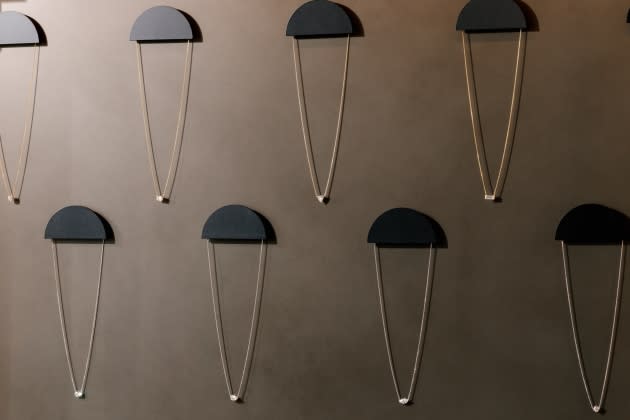Diamond Foundry’s Jewelry Brand Vrai Wants to Own the Lab-grown Market

LONDON — Los Angeles-based jewelry label Vrai has been developing its lab-grown diamond collections since 2014, long before the conversation around the manmade stones — presented as sustainable alternative to mined diamonds — infiltrated the mainstream.
The debate around the sustainability credentials of mined versus lab-grown diamonds remains hot, and conclusions are far from being reached — but that hasn’t stopped demand for lab-grown diamonds to keep growing. It’s estimated that by 2030 lab-grown diamond production will reach $30 billion and Vrai, a vertically integrated business whose products are produced by the Diamond Foundry in San Francisco using top-end technology, wants to be a leader in that space.
More from WWD
The brand is already well-established across the U.S. with a new showroom on Melrose Place, Leonardo DiCaprio among its investors, and many a high-profile fashion collaboration, including Amanda Hearst, Arizona Muse and Givenchy’s Matthew Williams. The latter worked with the jewelry label to produce a bespoke high jewelry piece for Kendall Jenner to wear at the Met Gala last September.
Now, to further its mission of owning the lab-grown space, the company is turning its focus onto Europe and setting some ambitious retail rollout plans to mirror its success in the U.S., as well as China, where it has an established client base and a showroom in Shanghai.
It has already set up a base in Copenhagen, given how far ahead the Danish capital stands in terms of sustainable innovation.
“A business is all about its people and we found great people in Copenhagen. Everyone is very value-driven and focused on working for a business that’s making a social impact,” said Vrai chief executive officer Mona Akhavi. “It really made sense for us to start there, because Copenhagen already has that community which is focused on expanding sustainable fashion and luxury in the world, as well as leading conferences like the Copenhagen Fashion Summit.”
Its sustainability credentials are one of the brand’s strongest cards. One of the biggest criticisms around lab-grown diamond production is the amount of energy used to create manmade stones in labs. Yet Vrai and the Diamond Foundry are setting themselves apart by using proprietary plasma reactors powered by renewable hydropower and ensure their products are carbon neutral.
Having a base in Copenhagen meant easy access to leading environmental organizations which worked with the brand to certify the Diamond Foundry as the first carbon neutral producer in the world.
“We looked at everything from technology to our energy intake and how many of our employees are driving to the office. That naturally sets the tone for everything else we do,” added Akhavi, also pointing to the company’s use of compostable packaging and recycled gold.
But when it comes to expanding its retail footprint, the company is prioritizing European markets such as the U.K., France, Germany and Spain, where customers have already been showing a growing appetite for lab-grown jewels by shopping on the Vrai e-commence platform.
After a year of facilitating virtual appointments during lockdown, the company has opened its first U.K. showroom which already has a fully booked schedule of appointments, according to Akhavi.
“The U.K. was immediately an important base for us because of existing consumer demand and education around the lab-grown market. Some of the larger legacy jewelers, which have strong bases in the U.K. and Europe, started either using or producing lab-grown diamonds — and that created a great opening ground for us,” she said, adding that the company has been building on existing market awareness with dedicated communications on the brand’s transparent supply chains and design capabilities.
“The definition of luxury is changing and consumers want to know where their product is coming from, and what impact it has. Really educating the U.K. audience about our values was the first step, because this is a market that’s very curious, fashion-forward and well-educated.”
During lockdown there was a 120 percent growth in the engagement ring category and the brand’s customization business grew fivefold, so as the world opens up Akhavi wants to build on the momentum by sticking to the showroom model across Europe and offering customers intimate, one-on-one appointments.
The aim is to keep collaborating with designer brands and influencers in the fashion and sustainability space, “to show everything that can be done with lab-grown diamonds.”
“We have everything from customizable classics to more edgy collections and high jewelry pieces that go all the way up to $85,000 and feature up to seven different diamond cuts in one bracelet,” said Akhavi, adding that these collections are then marketed in a way that’s “confident, luxurious but not intimidating or pretentious.”
Plans to partner with select department stores are also in the works, but the company is only seeing these as pop-up experiences and wants to retain control of the retail journey with a d-to-c model.
“We’re seeing the acceptance from all of the forward-thinking, luxury houses and retailers we work with,” said Akhavi, pointing to collaborations with Dover Street Market, Harrods and Galeries Lafayette.
“The data is there, the numbers are there, and we’re seeing the evidence upfront that customers are getting more educated, the spending power of the younger generation is growing and this part of the industry is positioned for substantial growth, it’s just a matter of what the luxury legacy brands decide to do: continue competing, or catch up and truly innovate.”
Sign up for WWD's Newsletter. For the latest news, follow us on Twitter, Facebook, and Instagram.